Freshwater pearl mussel
| Freshwater pearl mussel | |
|---|---|
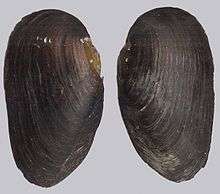 | |
| The exterior of the shell of Margaritifera margaritifera | |
| Scientific classification | |
| Kingdom: | Animalia |
| Phylum: | Mollusca |
| Class: | Bivalvia |
| Order: | Unionoida |
| Family: | Margaritiferidae |
| Genus: | Margaritifera |
| Species: | M. margaritifera |
| Binomial name | |
| Margaritifera margaritifera Linnaeus, 1758 | |
The freshwater pearl mussel, scientific name Margaritifera margaritifera, is an endangered species of freshwater mussel, an aquatic bivalve mollusc in the family Margaritiferidae.
Although the name "freshwater pearl mussel" is often used for this species, other freshwater mussel species can also create pearls and some can also be used as a source of mother of pearl. In fact, most cultured pearls today come from Hyriopsis species in Asia, or Amblema species in North America, both members of the related family Unionidae; pearls are also found within species in the genus Unio.
The interior of the shell of Margaritifera margaritifera has thick nacre (the inner mother of pearl layer of the shell). This species is capable of making fine-quality pearls, and was historically exploited in the search for pearls from wild sources. In recent times, the Russian malacologist Valeriy Zyuganov received worldwide reputation after he discovered that the pearl mussel exhibited negligible senescence and he determined that it had a maximum lifespan of 210–250 years.[2][3] The data of V.V. Zyuganov have been confirmed by the Finnish malacologists[4] and gained general acceptance.
Subspecies
Subspecies within the species Margaritifera magaritifera include:
- Margaritifera margaritifera margaritifera (Linnaeus, 1758)
- Margaritifera margaritifera parvula (Haas, 1908)
- Margaritifera margaritifera durrovensis Phillips, 1928 - critically endangered subspecies in Ireland.[5] Synonym: Margaritifera durrovensis. This subspecies is mentioned in annexes II and V of Habitats Directive as Margaritifera durrovensis.
Description
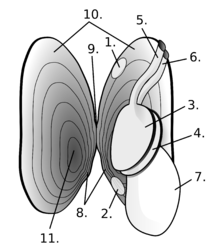
- Posterior adductor muscle
- Anterior adductor muscle
- Frontal gill
- Back gill
- Exhalant aperture
- Inhalant aperture
- Foot
- Pseudotooth
- The hingeline and ligament
- Mantle
- The shell's thickest part, the umbo
The freshwater pearl mussel is one of the longest-living invertebrates in existence.[6] The oldest known specimen in Europe was caught in 1993 in Estonia when it was 134 years old.[7]
Like all bivalve molluscs, the freshwater pearl mussel has a shell consisting of two parts that are hinged together, which can be closed to protect the animal's soft body within.[8] The shell is large, heavy and elongated,[9][10] typically yellowish-brown in colour when young and becoming darker with age.[6] Older parts of the shell often appear corroded, an identifying feature of this mussel species.[11] The inner surface of the shell is pearl white, sometimes tinged with attractive iridescent colours.[9] Like all molluscs, the freshwater pearl mussel has a muscular 'foot';[8] this very large, white foot enables the mussel to move slowly and bury itself within the bottom substrate of its freshwater habitat.[9][10]
Distribution
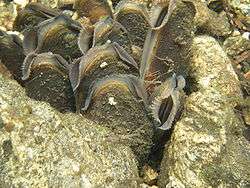
The native distribution of this species is Holarctic. The freshwater pearl mussel can be found on both sides of the Atlantic,[9] from the Arctic and temperate regions of western Russia, through Europe to northeastern North America.[6]
- North America: eastern Canada and New England in the United States' Northeast[12][13]
- Europe, including:
- Austria - estimated total population of 70 000 individuals in Mühlviertel (declining) and in Waldviertel (some recruitment), in the states of Upper and Lower Austria, respectively.[14]
- Belgium
- Czech Republic - critically endangered (CR).[15][16] In Bohemia, probably locally extinct in Moravia.[17] Listed in Decree for implementation, No. 395/1992 Sb. (Czech code) (in Czech: Vyhláška 395/1992 Sb. ve znění vyhl. 175/2006 Sb.) as Critically Threatened species. Its Conservation status in 2004-2006 is bad (U2) in report for European commission in accordance with Habitats Directive.[18]
- Denmark
- Estonia
- Fennoscandia - vulnerable in Finland and Norway, endangered in Sweden.[19][20][21] Very rare in southern Finland, more common in the north. Widespread but not common in Norway; Norway is considered to host a large proportion of the European stock. Rare in Sweden.[22] Also in Kola Peninsula and Karelia (Russia) (see below).
- France[23]
- Germany - critically endangered (vom Aussterben bedroht).[24] Listed as strictly protected species in annex 1 in Bundesartenschutzverordnung.
- Great Britain. More than half the world's recruiting population exists in Scotland with populations in more than 50 rivers, mainly in the Highlands, although illegal harvesting has seriously affected their survival. 75% of sites surveyed in 2010 had suffered "significant and lasting criminal damage" and in response the police and Scottish Natural Heritage have launched a campaign to protect the species.[25][26] This species has been fully protected in the United Kingdom under the Wildlife and Countryside Act 1981 since 1998 and partly protected according to section 9(1) since 1991.[27]
- Iberian Peninsula (Portugal and Spain)
- Ireland. The Cladagh (Swanlinbar) river contains one of the largest populations surviving in northern Ireland, estimated minimum 10,000, confined to a 6 km stretch of undisturbed river in the middle section.[28]
- Luxembourg
- Latvia
- Lithuania - extinct
- Poland - extinct[29][30]
- Russian Federation - in the rivers of the White Sea basin of the Arkhangelsk and Murmansk Regions. It is east border of the area of distribution M. margaritifera.
Habitat
Clean, fast-flowing streams and rivers are required for the freshwater pearl mussel,[6][9] where it lives buried or partly buried in fine gravel and coarse sand,[6] generally in water at depths between 0.5 and 2 metres, but sometimes at greater depths.[9] Clean gravel and sand is essential, particularly for juvenile freshwater pearl mussels, for if the stream or river bottom becomes clogged with silt, they cannot obtain oxygen and will die.[9] Also essential is the presence of a healthy population of salmonids, a group of fish including salmon and trout, on which the freshwater pearl mussel relies for part of its life cycle.[9]
Lifecycle
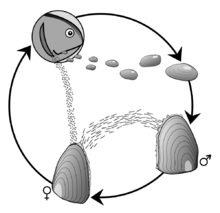
Capable of living for up to 130 years,[31] the freshwater pearl mussel begins life as a tiny larva, measuring just 0.6 to 0.7 millimetres long, which is ejected into the water from an adult mussel in a mass of one to four million other larvae. This remarkable event takes place over just one to two days, sometime between July and September.[6] The larvae, known as glochidia, resemble tiny mussels, but their minute shells are held open until they snap shut on a suitable host. The host of freshwater pearl mussel larvae are juvenile fish from the salmonid family, which includes the Atlantic salmon and sea trout.[6] The chances of a larva encountering a suitable fish is very low,[11] and thus nearly all are swept away and die; only a few are inhaled by an Atlantic salmon or sea trout, where they snap shut onto the fish's gills.[6]
Attached to the gills of a fish, the glochidia live and grow in this oxygen-rich environment until the following May or June, when they drop off. The juvenile must land on clean gravely or sandy substrates if it is to successfully grow.[6] Attached to the substrate, juvenile freshwater pearl mussels typically burrow themselves completely into the sand or gravel, while adults are generally found with a third of their shell exposed.[6] Should they become dislodged, freshwater pearl mussels can rebury themselves, and are also capable of moving slowly across sandy sediments, using their large, muscular foot.[6]
The freshwater pearl mussel grows extremely slowly,[11] inhaling water through exposed siphons, and filtering out tiny organic particles on which it feeds.[6] It is thought that in areas where this species was once abundant, this filter feeding acted to clarify the water, benefiting other species which inhabited the rivers and streams.[6] Maturity is reached at an age of 10 to 15 years,[6] followed by a reproductive period of over 75 years in which about 200 million larvae can be produced.[11] In early summer each year, around June and July, male freshwater pearl mussels release sperm into the water, where they are inhaled by female mussels. Inside the female, the fertilized eggs develop in a pouch on the gills for several weeks, until temperature or other environmental cues trigger the female to release the larvae into the surrounding water.[6]
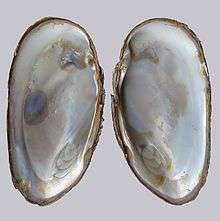
Threats and conservation
Once the most abundant bivalve mollusc in ancient rivers around the world, numbers of the freshwater pearl mussel are now declining in all countries and this species is nearly extinct in many areas.[9] The causes of this decline are not fully understood, but alteration and degradation of its freshwater habitat undoubtedly plays a central role.[9] The negative impacts humans have on rivers and streams come from a wide range of activities such as river regulation, drainage, sewage disposal, dredging, and water pollution, including the introduction of excess nutrients.[9] Anything that affects the abundance of the fish hosts will also affect the freshwater pearl mussel; for example, the introduction of exotic fish species, such as the rainbow trout, reduce the number of native fish hosts.[9] Introduced species are also directly affecting the freshwater pearl mussel; the invasion of the zebra mussel (Dreissena polymorpha), which has been spread to new locations by being transported on the bottom of boats or in ballast waters, has impacted freshwater pearl mussel populations in all countries it has invaded.[9]
The freshwater pearl mussel, which is completely protected in all European countries,[32][33] has been the focus of a significant amount of conservation efforts.[34] Measures have included the transfer of adult mussels to areas where it had gone extinct,[34][35] the culture of juvenile mussels, and the release of juvenile trout, which have been infected with glochidia, into small rivers, but mainly the freshwater pearl mussel has benefited from habitat restoration projects in some areas.[35] Due to the essential role salmonid fish play in the life of the freshwater pearl mussel, the conservation of salmon and trout is also central in the survival of this endangered freshwater mussel.[9]
References
This article incorporates text from the ARKive fact-file "Freshwater pearl mussel" under the Creative Commons Attribution-ShareAlike 3.0 Unported License and the GFDL.
- ↑ Mollusc Specialist Group (1996). "Margaritifera margaritifera". IUCN Red List of Threatened Species. Version 2006. International Union for Conservation of Nature. Retrieved 13 Jan 2007.
- ↑ Ziuganov, V.; San Miguel, E.; Neves, R.J.; Longa, A.; Fernandez, C.; Amaro, R.; Beletsky, V.; Popkovitch, E.; Kaliuzhin, S.; Johnson, T. (2000). "Life span variation of the freshwater pearlshell: a model species for testing longevity mechanisms in animals.". Ambio. ХХIX (2): 102–105. doi:10.1579/0044-7447-29.2.102.
- ↑ Зюганов В.В. (2004). "Арктические долгоживущие и южные короткоживущие моллюски жемчужницы как модель для изучения основ долголетия.". Успехи геронтол. 14: 21–31.
- ↑ Helama S.; Valovirta I. (2008). "The oldest recorded animal in Finland: ontogenetic age and growth in Margaritifera margaritifera (L. 1758) based on internal shell increments." (PDF). Memoranda Soc. Fauna Flora Fennica. 84: 20–30.
- ↑ 2007 IUCN Red List – Search
- 1 2 3 4 5 6 7 8 9 10 11 12 13 14 15 Skinner, A., Young, M. and Hastie, L. (2003) Ecology of the Freshwater Pearl Mussel. Conserving Natura 2000 Rivers. Ecology Series No. 2. English Nature, Peterborough.
- ↑ Ulvar Käärt. "Kas teadsid, et Eesti loomariigi vanuserekord sai 20-aastaseks." Eesti Päevaleht 16. veebruar 2013. (Estonian)
- 1 2 Burnie, D. (2001) Animal. Dorling Kindersley, London.
- 1 2 3 4 5 6 7 8 9 10 11 12 13 14 Araujo, R. and Ramos, M.A. (2000) Action Plan for Margaritifera margaritifera in Europe. Council of Europe, Strasbourg.
- 1 2 Moorkens, E.A. (1999) Conservation Management of the Freshwater Pearl Mussel Margaritifera margaritifera. Part 1: Biology of the Species and its Present Situation in Ireland. Irish Wildlife Manuals, No. 8. Dúchas, The Heritage Service, Dublin.
- 1 2 3 4 Lampert, W. and Sommer, U. (1996) Limnoecology: The Ecology of Lakes and Streams. Oxford University Press, Oxford.
- ↑ Smith, Douglas G. (July 1976). "Notes on the Biology of Margaritifera margaritifera margaritifera (Lin.) in Central Massachusetts". American Midland Naturalist. The University of Notre Dame. 96 (1): 252–256. doi:10.2307/2424588. JSTOR 2424588.
- ↑ Bauer, G. (June 1987). "Reproductive Strategy of the Freshwater Pearl Mussel Margaritifera margaritifera". Journal of Animal Ecology. British Ecological Society. 56 (2): 691–704. doi:10.2307/5077. JSTOR 5077.
- ↑ Gumpinger, Clemens; Wolfgang Heinisch; Johannes Moser; Thomas Ofenböck; Claus Stundner (2002). Die Flussperlmuschel in Österreich (PDF). Wien: Umweltbundesamt. ISBN 3-85457-644-7.
- ↑ Juřičková L., Horsák M. & Beran L., 2001: Check-list of the molluscs (Mollusca) of the Czech Republic. Acta Soc. Zool. Bohem., 65: 25-40.
- ↑ Red List of the molluscs (Mollusca) of the Czech Republic http://mollusca.sav.sk/malacology/redlist.htm
- ↑ (Czech) Horsák M., Juřičková L., Beran L., Čejka T. & Dvořák L. (2010). "Komentovaný seznam měkkýšů zjištěných ve volné přírodě České a Slovenské republiky. [Annotated list of mollusc species recorded outdoors in the Czech and Slovak Republics]". Malacologica Bohemoslovaca, Suppl. 1: 1-37. PDF.
- ↑ Dušek J., Hošek M. & Kolářová J. (2007) Hodnotící zpráva o stavu z hlediska ochrany evropsky významných druhů a typů přírodních stanovišť v České republice za rok 2004-2006. - Ochrana přírody, 62(5): appendix 5:I-IV. (in Czech language)
- ↑ "Threatened and Near Threatened molluscs". 2001.
- ↑ "Artsdatabanken". 2010.
- ↑ "ArtDatabanken". 2010.
- ↑ cited 16 February 2007
- ↑ "Recherche de sites par espèce: Invertébrés: Moule perlière (Margaritifera margaritifera)". 2007.
- ↑ Glöer P. & Meier-Brook C. (2003) Süsswassermollusken. DJN, pp. 134, page 109, ISBN 3-923376-02-2
- ↑ "Invertebrate species: molluscs". Joint Nature Conservation Committee. Retrieved 13 January 2007.
- ↑ "Police crack down on illegal 'ransacking' of mussel sites". Glasgow: The Herald. 26 May 2010.
- ↑ Protection for wild animals on Schedule 5 of the Wildlife and Countryside Act, 1981. website accessed 7 August 2009.
- ↑ "Cladagh (Swanlinbar) River" Joint Nature Conservation Committee. Retrieved 31 May 2010.
- ↑ Margaritifera margaritifera - Polska Czerwona Księga Zwierząt - Bezkręgowce
- ↑ pl:Polska Czerwona Księga Zwierząt - Bezkręgowce
- ↑ Sturm, C.F., Pearce, T.A. and Valdés, A. (2006) The Mollusks: A Guide to Their Study, Collection, and Preservation. Universal-Publishers, Boca Raton, Florida.
- ↑ Listed as Annex II species of the European Habitats Directive
- ↑ Young, M.R. (1991) Conserving the freshwater pearl mussel (Margaritifera margaritifera L.) in the British Isles and Continental Europe. Aquatic Conservation: Marine and Freshwater Ecosystems, 1(1): 73 - 77.
- 1 2 Scottish Natural Heritage (October 2008).
- 1 2 Hastie, L.C. and Young, M.R. (2003) Conservation of the Freshwater Pearl Mussel I. Captive Breeding Techniques. Conserving Natura 2000 Rivers Conservation Techniques Series No. 2. English Nature, Peterborough.
Further reading
- Anonymous 2004. Margaritifera margaritifera. Stage 1 and Stage 2 survey guidelines. Irish Wildlife Manuals, No. 12. National Parks and Wildlife Service, Department of Environment, Heritage and Local Government, Dublin, Ireland. 25 pp.
- Moorkens E. A. 2000. Conservation Management of the Freshwater Pearl Mussel Margaritifera margaritifera. Part 2: Water Quality Requirements. Irish Wildlife Manuals, No. 9., 44 pp.
- Makhrov A., Bespalaya J., Bolotov I., Vikhrev I., Gofarov M., Alekseeva Ya., Zotin A. 2013. Historical geography of pearl harvesting and current status of populations of the freshwater pearl mussel Margaritifera margaritifera (L.) in west part of Northern European Russia. – Hydrobiologia. DOI 10.1007/s10750-013-1546-1
- Bolotov, I.N., Yu.V. Bespalaya, A.A. Makhrov, P.E. Aspholm, A.S. Aksenov, M.Yu. Gofarov, G.A. Dvoryankin, O.V. Usacheva, I.V. Vikhrev, S.E. Sokolova, A.A. Pashinin & A.N. Davydov, 2012. Influence of Historical Exploitation and Recovery of Biological Resources on Contemporary Status of Margaritifera margaritifera L. and Salmo salar L. Populations in Northwestern Russia. - Biology Bulletin Reviews 2(6): 460–478. DOI 10.1134/S2079086412060035
- Bespalaya Yu.V., Bolotov I.N., Makhrov A.A., Vikhrev I.V. 2012. Historical Geography of Pearl Fishing in Rivers of the Southern White Sea Region (Arkhangelsk Oblast). - Regional Research of Russia 2(2): 172–181. DOI 10.1134/S2079970512020025
- Bespalaja Yu.V., Bolotov I.N., Makhrov A.A. 2007. State of the Population of the European Pearl Mussel Margaritifera margaritifera (L.) (Mollusca, Margaritiferidae) at the Northeastern Boundary of Its Range (Solza River, White Sea Basin). - Russ. J. Ecol. 37(3): 222-229. DOI 10.1134/S1067413607030095
- Bolotov I. N., A. A. Makhrov, Yu. V. Bespalaya, I. V. Vikhrev, O. V. Aksenova, P. E. Aspholm, M. Yu. Gofarov, A. N. Ostrovskii, I. Yu. Popov, I. S. Pal'tser, M. Rudzite, M. Rudzitis, I. S. Voroshilova, S. E. Sokolova 2013. Results of testing the comparatory method: The curvature of the shell valve frontal section is inappropriate as a systematic character for the freshwater pearl mussel of the genus Margaritifera. Biology Bulletin 40(2): 221-231. DOI 10.1134/S1062359013020027
External links
| Wikimedia Commons has media related to Margaritifera margaritifera. |
- Freshwater pearl mussel media at ARKive

- Pesticides Database - Chemical Toxicity Studies
- University of Helsinki - Science of River Pearl Mussel
- UK Biodiversity Action Plan
- Russian Margaritifera Research Consortium
